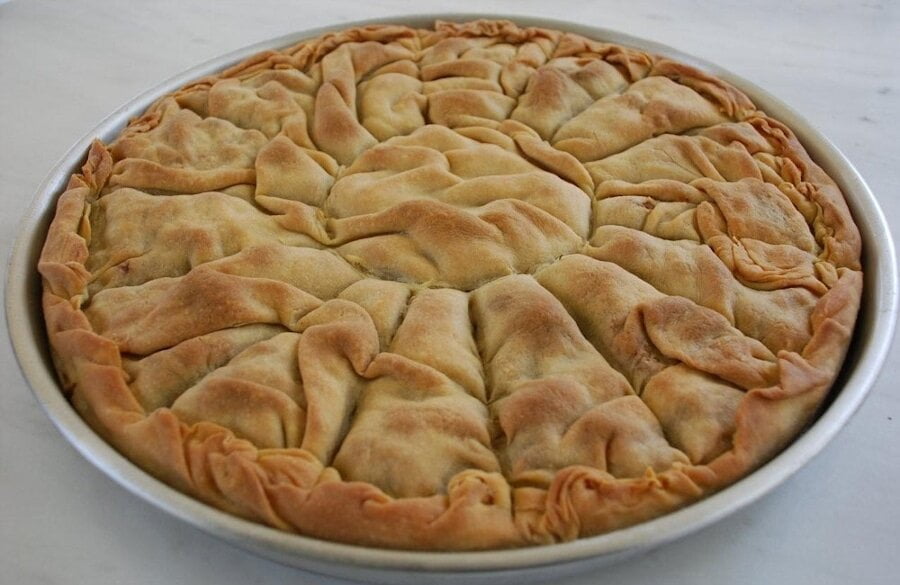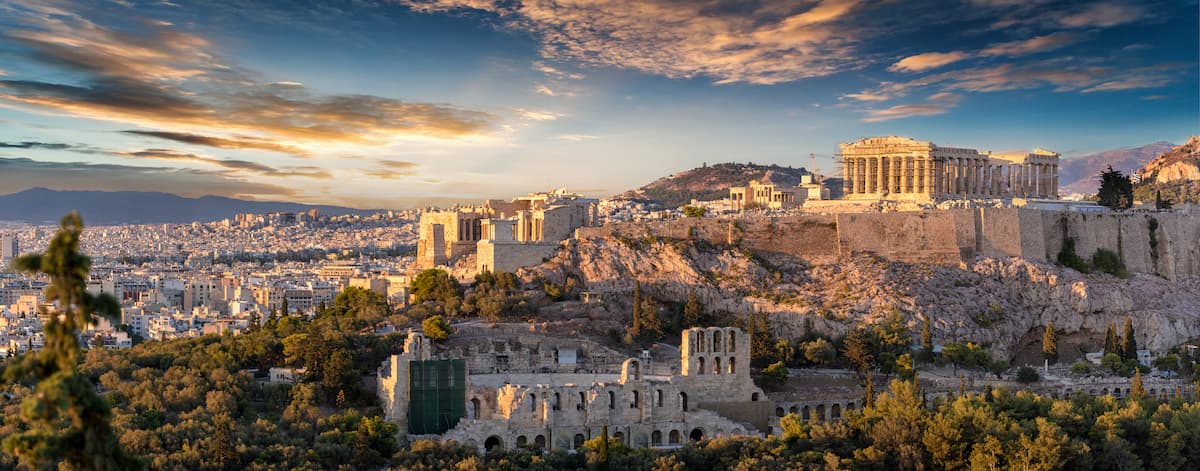Adapted to climatic conditions, the seasonal calendar and rhythms of agriculture define the diets of the people of Epirus. The nutritional habits of its residents are the product, of their relationship with nature and the living world on the one hand, and of their religious consciousness on the other. Their diet is tied to the Christian calendar and the customs related to religious festivals and social events.
Characteristic of the Epirus cuisine is the variety of special pitas, 31 pies have been documented in 15 villages of Epirus, dairy products, like yellow cheese and feta, milk, butter, and yogurt, meat products like chicken, lamb, beef, pork, goat and wild game, tsipouro, wine and, naturally, sweets (mainly baked) with their Eastern aromas and colors.
In Epirus, where food and environment are brought together harmoniously, you can feel life’s warm embrace. The earth, nature, structures, and spaces bear memories and mysteries, places bedecked with the loveliest ornaments the earth can provide. People who nurture the values of earlier generations, customs, and human connections. Here, food engages all the senses…
With its mountainous terrain, the difficult weather conditions but also the great natural wealth (mountain range of Pindos), Epirus is a region steeped in history, a region that if you experience and understand it you will never want to leave!
Adapted to climatic conditions, the seasonal calendar and rhythms of agriculture define the diets of the people of Epirus. The nutritional habits of its residents are the product, of their relationship with nature and the living world on the one hand, and of their religious consciousness on the other. Their diet is tied to the Christian calendar and the customs related to religious festivals and social events.
Characteristics of the Epirus cuisine are the variety of special pita; its dairy products, like yellow cheese and feta, milk, butter, and yogurt, meat products like chicken, lamb, beef, pork, goat and wild game, tsipouro, wine and, naturally, sweets (mainly baked) with their Eastern aromas and colors.
Folklore professor Michalis G. Meraklis wrote: “Tradition is not something abstractly ideological. You experience it by eating a delicious Epirus pita “. Epirus is a paradise of pies!
31 different pita have been recorded in 15 villages of Epirus (as described by Andreas Stefopoulos, author and dietician) and which differ from region to region and from village to village. The pies are eaten without bread, without a main dish, and without accompaniments. They are made by the housewives to please the guests, the craftsmen, and the workers, and at the same time, pie-making represents an exit from the routine of daily cooking. In the olden days, pies used to be baked on stones on a baking tray, but also in a large casserole in a wood-fired oven. Here are some of them:
Alevropita or kourkoutopita: made with flour, eggs, white grated cheese, milk, and butter. It is eaten very hot and cut into pieces as a welcome treat.
Pispilita or Blatsaria: naked (without filo) pita with corn flour, various wild greens, trahana, cheese, olive oil, and butter. The nettle pie is similar but with filo.
Cassiata: pita with filo, olive oil, butter, and feta cheese. Its peculiarity is that the filo layers alternate in the pan with and without cheese. When baked, the result is like cheese millefeuille!
Mintita (pumpkin pie): naked pie (without filo) with corn flour, pumpkin, trahana, cheese, butter, and olive oil.
Pita strifti (‘twisted pie’): pita with filo layers and a filling of leeks, cheese, trahana, olive oil, and butter.
Tyrogliata: pita with fresh cheese from Metsovo.
Galatopita: sweet pita with filo, eggs, sheep’s milk, and sugar. Lay the filo layers in a pan, fill with cream based on flour and eggs, cover with filo layers on top, spread with butter and egg, and bake in the oven.
Pita with zygouri (lamb): the most complicated pie of winter (mainly Carnival) when the lambs have grown up. Lots of filo layers around and inside, trahana, milk, eggs, and, of course, meat.
Other local dishes:
Rithanadema: a special pilaf baked in the oven in a pan where the rice gradually draws the broth of the chicken that has been boiled first. The rice is then mixed with sauteed onions, parsley, and grated feta cheese, while the chicken meat is placed in the center, with pieces of butter on top.
Leeks with plums: leeks, onion, olive oil, tomato juice, nutmeg, salt and pepper.
Eel with laurel leaves on the tiles: eels abound in the lake of Ioannina. This dish is distinguished by its finesse since laurel leaves are placed between the slices of fish sealed at the edges with dough, and yield their aroma when baked on tiles.
The local Horta: poppy (Sourlina), Zochia, Genia Tou Papa (‘priest’s beard’), psaroulia, wild carrot, ktenaki, nettle, bruva or lapsana, thistle, moscholachano, celery or paza, and spinach. Let us say here that Pindos is very rich in wild horta greens), many of which are aromatic.
Karavides (crayfish) skordalia: we find them on the island of Kyra Frosini in the lake of Ioannina in the numerous taverns that serve frog legs, trout, and fish from the lake. This is a delicious food where the crayfish are first boiled and shelled, and their shells are used to prepare a rich skordalia with walnut and a little of the shell’s broth that is served on top of the fried and shelled crayfish.
Amvrakikos Gambares (shrimp of Amvrakikos Gulf) with garlic: a dish made preferably with fresh garlic which is steamed in a saucepan over low heat. Fresh tomatoes and olive oil are then added to the shelled shrimp
Goumidia: a type of fricassee made with lamb liver and head, onions, parsley, dill, spearmint, cabbage or spinach, white wine, and butter. Beaten egg whites are added during cooking to thicken the texture.
Leeks with Metsovo meatballs: meatballs made from mutton and beef, onion, parsley, eggs, trachana, oregano and red pepper. After the meatballs are kneaded and formed, they are boiled on a layer of sauteed leeks with celery and tomato juice.
Gigantes (‘giants’) with wild horta: very large beans boiled with various mountain horta, onion, tomato juice, spearmint, parsley, and garlic.
Dairy Products:
Epirus is rich in dairy products, such as yogurt, chlorotiri, pagouda, afrogalo, galotiri, gouliastra and trofali. Do not forget the newest products such as Metsovone, feta and kefalograviera.
Wine:
When we talk about continental wines, we refer to the vineyards of Metsovo and Zitsa. Greece’s most mountainous vineyard in Metsovo impresses with its sloping vineyards, which in spring and summer create beautiful natural ‘paintings’ perched on the steep mountain slopes.
More central and to the west is the plateau of Zitsa, the “kingdom” of Debina, the elegant white variety that is distinguished both for the still and for the sparkling wines that it produces.
In Zitsa we have PDO white wines, both still and sparkling, exclusively from 100% Debina.
In Metsovo, both red and white PGI wines are produced, from Cabernet Sauvignon, Merlot, Cabernet Franc, Gewürztraminer, Debina, and Vlachiko.
Protected Designation of Origin (PDO) and Protected Geographical Indication (PGI) products:
| Product | Designation of Origin and Geographical indication | Prefecture |
| Olive oil | Preveza (PGI) | Preveza |
| Olives | Konservoelia (PGI) | Arta |
| Cheese | Metsovone (PDO) | Ioannina |
| Cheese | Feta (PDO) | Arta, Thesprotia, Ioannina, Preveza |
| Cheese | Kefalograviera (PDO) | Arta, Thesprotia, Ioannina, Preveza |
| Cheese | Galotiri (PDO) | Arta, Thesprotia, Ioannina, Preveza |
| Wine | Ipiros (PGI) | All prefectures |
| Wine | Zitsa (PDO) | Ioannina |
| Wine | Metsovo (PGI) | Ioannina |
| Wine | Ioannina (PGI) | Ioannina |




